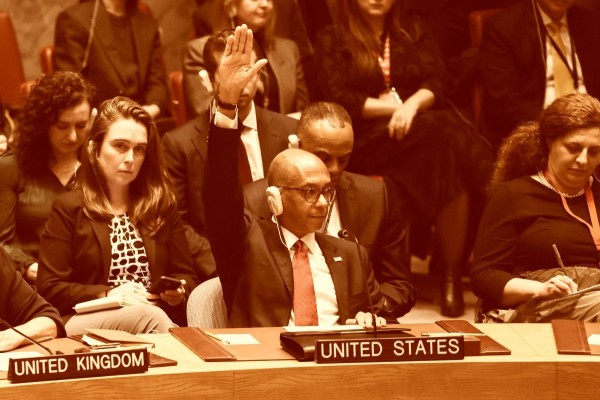Guantánamo redux
Trump’s plan to send 30,000 migrants to Guantánamo Bay is one facet of a new concerted attack on the rights of refugees

Two US Army military police escort a detainee, dressed in an orange jumpsuit, to a cell at Camp X-Ray, Guantánamo Bay Navy Base, Cuba. Photo by Mate 1st Class Shane T. McCoy/Wikimedia Commons.
The human rights situation in Cuba is bad, and about to get worse. Prisoners will be denied basic constitutional rights and reports of abuse and torture will surface. No, we are not talking about the treatment of dissidents opposed to the revolutionary government—but rather the victims of US policy in the tropical gulag of Guantánamo.
If Donald Trump follows through on his threats, as many as 30,000 “criminal illegal aliens” will soon be housed in tents at the Guantánamo Naval Base on the southeast coast of Cuba. This week the first flights transporting prisoners arrived there.
Pete Hegseth, the new, controversial secretary of defense noted that “these criminals trampled over our previously wide open borders to bring violence and mayhem to our communities.” But is that really the case?
A little history is helpful to understand the current human rights tragedy.
Guantánamo is a 45-square-mile US military post in Cuba. It was ceded to the United States as a coaling and naval station in 1903 following US military occupation of Cuba that started in 1898. Every year Washington tries to pay the annual rent of $4,085. The Cuban government refuses to accept the money, instead asking the US to vacate Cuban territory.
The military base got a renewed lease on life with the “war on terror” during the George W. Bush presidency. Following the attacks of September 11, 2001, a detention centre was established for “enemy combatants”—a term deliberately used to avoid providing them with the protection of the Geneva Conventions and resulting in constant violations of international law.
In all, some 780 people passed through the camp, suspected of terrorism, most without charges ever being laid. Some detainees have been held for 20 years without charge. Only seven were ever convicted of terrorism, and approximately 98 percent were released. Seven committed suicide rather than continue to live in such abusive conditions. Today, 15 detainees remain.
Many of those who were held in Guantánamo were tortured—waterboarding, sleep deprivation and force feeding of inmates were all familiar practices. In a March 2024 report, Amnesty International condemned the “legacy of torture, indefinite detention, Islamophobia and injustice” that resulted from US policy there, noting that prisoners were consistently deprived of basic human rights.
It’s worth pointing out that prominent Canadian politicians did criticize the treatment of prisoners at the detention centre. In February 2007, six former Canadian foreign ministers (Joe Clark, Lloyd Axworthy, Flora MacDonald, Bill Graham, John Manley and Pierre Pettigrew) condemned the abuses committed there and called on Prime Minister Stephen Harper to lobby Washington to ensure fair treatment for prisoners.
Child soldier Omar Khadr, who was just 15 when he was shot and captured in a battlefield in Afghanistan, spent eight years there. He ultimately received $10.5 million from the Canadian government in compensation for the wilful violation of his Charter rights.
When the prison facilities were set up in January 2002, President Bush said that it would house the “worst of the worst.” Some 23 years later, President Trump is now threatening to detain “the worst criminal illegal aliens threatening the American people. Some of them are so bad we don’t even trust the countries to hold them.” This has a familiar ring to it.
It’s also not a new strategy. In the 1990s, George H.W. Bush and Bill Clinton held thousands of Haitians and Cubans at the base. They had been intercepted at sea while seeking to reach the United States and were detained while their asylum claims were processed. They were not housed in the high-security detention centre set up after the September 11 attacks, but rather in basic shelters within barbed wire compounds.
At the height of this operation, up to 21,000 Haitians were held at Guantánamo. This was a deliberate strategy, since if they had reached US soil, they would be protected from repatriation under international law. By contrast, their legal rights were severely limited at the US military base (and away from public scrutiny). Most Haitians held at Guantánamo were subsequently repatriated.
Fresh off his electoral victory, Donald Trump has started his war on migrants and has threatened to deport all 11 million illegal immigrants rounded up by US Immigration and Customs Enforcement (ICE) officials. Guantánamo will soon, one again, become a large tropical prison, with many more victims of human rights abuses. And once again, this legal black hole will be used to prevent public scrutiny.
Trump has now unleashed a terror campaign, empowering the military to deport “illegals.” Vince Warren, executive director of the Center for Constitutional Rights, is concerned at the excesses of the new Trump policy: “Migrants and asylum seekers are being cast as the new terrorist threat, deserving to be discarded in an island prison, removed from legal and social services and supports.”
Sending 30,000 migrants to Guantánamo is one facet of a new concerted attack on the rights of refugees. In less than three weeks, Trump has deported hundreds of migrants to Colombia and Mexico. He has committed to sending thousands of troops to patrol the southern border. He has suspended entry into the United States of all undocumented migrants, turning them away without the right to asylum hearings. He has withheld funding to US sanctuary cities and cancelled a Biden-era program providing preferential treatment for citizens from Cuba, Venezuela and Nicaragua on humanitarian grounds.
The rhetoric being used by Trump is similar to that used in 2002 by the Bush administration when the first “terrorists” were sent to Guantánamo. Nothing has changed. Now there are plans for a 30,000 person “migrant facility,” with the inmates being painted as a threat to the United States. This is just the latest exploitation of Cuban territory—as well as a massive abuse of human rights.
John Kirk, is Professor Emeritus of Latin American Studies at Dalhousie University, and the author/co-editor of several books in Cuba.
Stephen Kimber is an Inglis Professor in the School of Journalism, Writing & Publishing at the University of King’s College and the award-winning author of 14 books.










